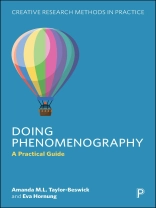This practical handbook provides a step-by-step guide for students who are new to phenomenography.
A qualitative research approach within the interpretivist paradigm, phenomenography explores the different ways in which humans conceive a phenomenon and ‘why’ and ‘how’ they do it. It is used in a wide range of academic subject areas from education to social work, physics and medicine. Today it is gaining popularity as a versatile and robust method with the aim of understanding other people’s perceptions.
Our practical guide features:
· advice on how to construct a phenomenographic research project;
· a thorough overview of the approach’s origins and its evolution;
· examples that show the influence it has across a range of subject and practice areas.
This book will empower readers in making informed decisions regarding the suitability of the phenomenographic approach for their research projects and provide them with the necessary tools to embark on their research journey.
Table of Content
Foreword by Sheila Webber
1. Why phenomenography and why now
2. Introducing phenomenography
3. Research design and ethics in phenomenographic work
4. Data generation in phenomenographic work
5. Phenomenographic transcription and data analysis
6. Presenting the findings of phenomenographic work
7. Conclusion
About the author
Eva Hornung is the Librarian of the City of Dublin ETB Curriculum Development Unit and a qualitative researcher.












